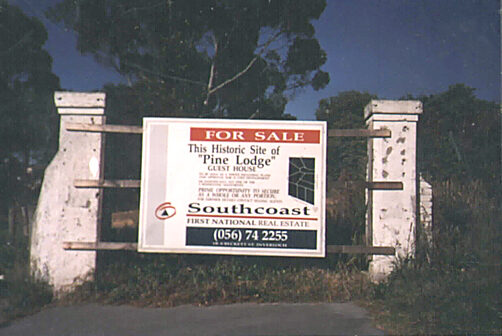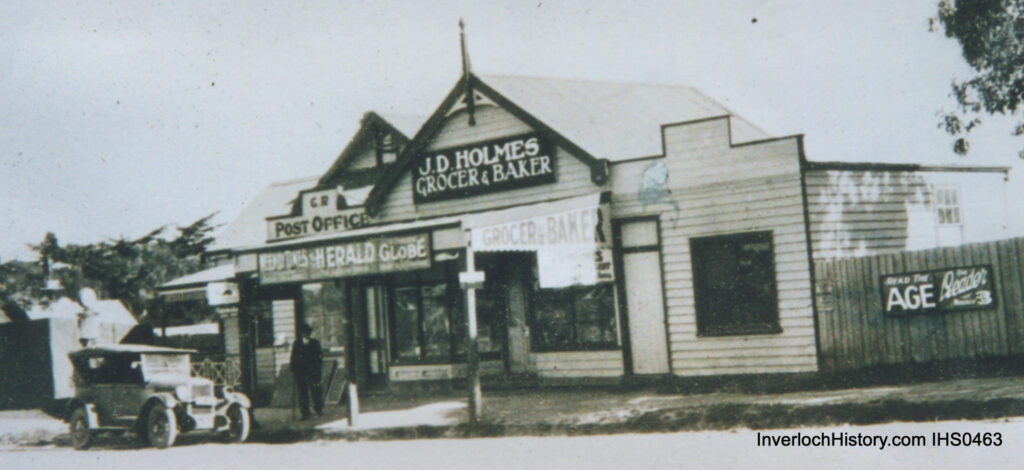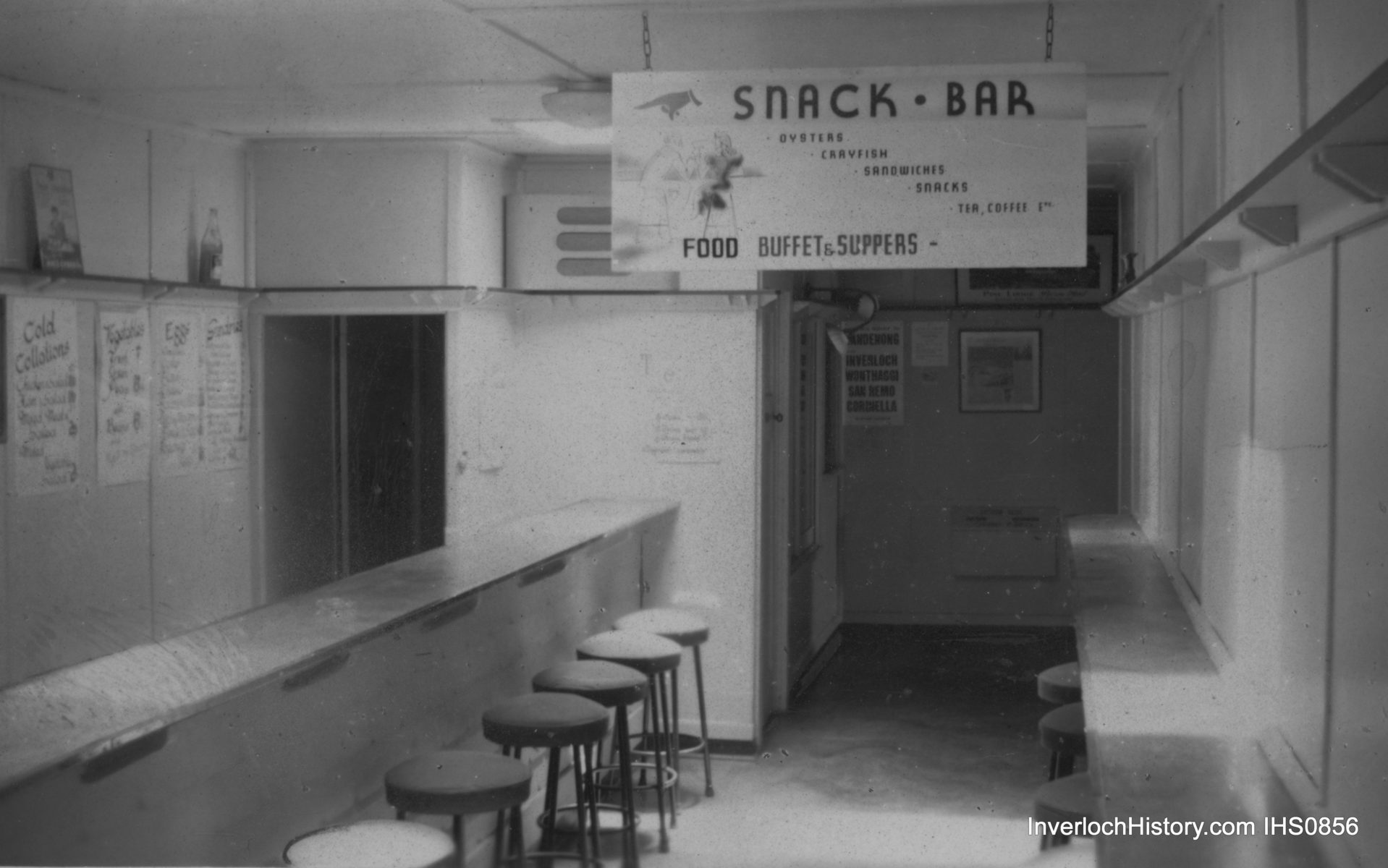Click here to download Newsletter #252 as a PDF


Members need no reminders about COVID 19 and the difficulties the year 2020 has presented to us. Our news is filled with it, but it is a fact of life. We cannot escape from its clutches and its consequences. The experience of the Inverloch Historical Society in handling COVID 19 is being repeated across all community groups in the district – no this, no that, no meetings, no discussions for decision making, and all wondering if our groups will survive.
Can I immediately assure you that our Society will survive, for we have maintained creative and necessary activities simply because the move to our new storage has highlighted just how much work is required, in not only setting up a storage facility, but in beginning to understand the much bigger picture involved.
I want you to imagine our new storage has now collected all the ‘treasures’ we have had stored up in our various houses and farm sheds. We have everything from photos, photocopies, typed and duplicated sheets of paper – all in their thousands. We also have many artifacts presented to us over the many years – some small, some large. We have various framed prints, display cards constructed by members, many maps some of which are in a delicate condition and even two full size human models which we use in our exhibitions and displays.
I want you to decide – what is the best way to store such a variety of items, considering our responsibility re-preservation? That is quite an important question, but the questions keep coming, for we now reach the point where we must decide – what is the best method/organization to logically list all we have? Will the system we decide upon seem logical and be easily readable. Can that system be accessioned in such a way that it becomes a tool in itself, so that research and investigations logically follow on?
With that batch of searching questions, I hope all members and our supporters begin to understand the mammoth task facing us. It is a challenge, but it is a worthy one. It is a never ending one, for as we add to the collection through donations, then we will be continually listing and recording what we have, an ongoing task for current and future members in the years to come
I therefore invite all members to come and see the new storage facility. We call it our green shed, and it is at the back of the Warrawee Centre very close to Bolding Place. Many people pass by the shed, and if you see the roller door open, come in and have a look. I know you will be impressed! Your questions will be welcomed.
JOHN HUTCHINSON (President)
Annual Subscriptions are due
The lifeblood of our organization is members. This year has been extraordinarily difficult with only one meeting in February, and we are trying to keep you in touch through an improved, readable and pictorial Newsletter. Please continue to support the Society by renewing your subscription, and it is hoped our General Meetings will resume as soon as is practical.
Membership type:
- Annual Individual Membership: $20
- Annual Couple/Family Membership: $32
Payment options:
- Cheque:
Send a cheque made out to “Inverloch Historical Society Inc” to
Treasurer, Inverloch Historical Society, Box 46, Inverloch VIC 3996.
Please clearly mark your name and any update in your address or e-mail address. - Bank Transfer:
Account Name: Inverloch Historical Society.
BSB No: 633 108
Account No: 158046474
Please be sure to include your name as the Transaction Reference
Historical Commentary
As one reads, it is fascinating to collect written commentary on history from a variety of places – sometimes books, magazines, spoken etc…I thought you may be entertained and challenged by some from my collection. Let’s start with something from the legendary Australian writer and poet – Henry Lawson.
“Progress from this low state was a definite sign of success, for glazed windows, iron roof, smooth timbered walls and floors, all cost hard cash. The iron roofs may have been a dubious advantage in hot weather: ‘God forgive the man who invented galvanized iron and the greed which introduced it into Australia”.
Can you imagine Australia without galvanized iron! Surely it is the most fundamental of building products used in this country! Some people are fascinated by the appearance of rust, adding to the colour of the landscape.
Here’s a little bit more of Henry Lawson, which I am sure many local ‘Inverlochians” will appreciate and understand.
“Once accepted into the ranks of a farming community, selectors achieved a degree of ‘social security’ which contrasted greatly with the sufferings of anonymous city workers hit by hard times”.
The final contribution comes from the pen of the English writer C.G.Grey. He makes a somewhat intellectual and emotional plea for the lessons of History.
“History is the greatest plagiarist in all literature, and repeats itself to such an extent that if one knew all history one would never make a mistake in life, because one would know all the mistakes which can be made.
There is precious little difference between today and the times when Nimrod imported foreign labour to build the Tower of Babel, or when Jacob swindled Laban over the cattle, or when Joseph cornered the corn-market in Egypt thanks to Imperial Preference, or when the Municipality of Rome under Augustus, decreed that blocks of flats in the Eternal City must be no more than eight stories high.
However, those who would rather learn from bitter experience than from history need not read this stuff”.
The Editor welcomes any contributions to this fascinating column supporting history.
Rambler Strikes Again!
This is the third and final writings from ‘Rambler’ written in March 1909. In today’s story, Rambler takes a trip to Eagles Nest, the Caves and Tarwin River. I’ve presented the writings, just as written.
“Another day we started for Eagles Nest rocks. We got to the Caves when a storm came on and we return wet to the skin. However we went another day and were well repaid for our long journey 6 or 7 miles. Went into the cave. But having no light did not go to the end, but got a photo of the opening. Went a mile further and had a good look at the Eagles Nest rocks, took 2 photos near and distant. All the rocks and cliff are very rare and beautiful. Such fantastic shapes. Got a few nice shells and sponges and Krumnice. Got two cray fish, not the first as we had eaten others of his catch. He did a lot of fishing, and he also went out with the net fishermen, starting just at dusk and staying out to midnight with them. He also went duck shooting. They are all the black kind and are excellent. Also teal. He shot a lot of waterfowl. The day we went up the Tarwin and the Captain turned the boat everyway so that they could be hauled in with the boat hook. Some days we went for drives (Horse & Buggy?). Krummel pair were in fine going condition so we went long distances in a few hours and saw a good lot of country about – there it is mostly level for 7 or 8 miles, and poor land although we saw good fat cattle on it. Plenty of water and shelter. Then the little hills commence and continue to Westernport Bay and the land is considered first class. We crossed the Powlet river near where the new coal mines are situated. It appears to be a continuation of the Cape Patterson seam and that was about the first coal discovered in Gippsland, and that has not been worked as it was too far away from a railway. This will be remedied when a line is made to Powlet.
Then the day came when we had to leave this interesting place (Inverloch). In the same way we went. The slow wagon to Outram where we took train to Kurramburra.
In due time we arrived home safe and well and want to go again.
From the archives
With ‘treasures’ now appearing in our central location at the Green Shed, I came across the following document, all nicely typed on pink A4 paper. It makes utterly fascinating reading, for here are the matters the Society thought were central to its role back in 1996. The writer was a former President of the Society – Nancye Durham, specially given as a guest speaker to the Inverloch Probus Club on 6th. June 1996. She entitled it “Re-Formation of Historical Society”.
“After a recent visit to the Wonthaggi Railway Station, I spoke with Eulalie Brewster to enquire if such an historical society or group existed in Inverloch. Eulalie indicated that for years she has maintained an Inverloch collection and has worked with the Woorayl Historical Society; but, there is nothing in Inverloch except individual collectors. She said there is a need, but it is difficult to interest people to form such a group. Having asked around in several areas, there does seem to be many interested and I have since indicated this to Eulalie and that I would pursue the matter further.
It is hoped that an Inverloch Historical Society will be formed. Initially we will need members, a meeting and working place, a storage area, equipment – ie…stationery. computer, recorder, tapes etc….
Ultimately we will need donors and contributions as our history is reflected in memorabilia – ie….books, photographs, newspaper items, artifacts, etc…We will cover not only pioneering individuals and families, but many organizations – ie….schools, churches, CWA, Red Cross, Warrawee, scouts, guides, brownies, library, Monash University ‘dig, Rotary, Probus, Apex, Lions. RSL. PO, hotels and guest houses, sporting clubs, cemetery trust, water board, Aged Hostel, shires, development and conservation, shipwrecks and tragedies etc…
If you are interested in this project could you leave your name, address and telephone number so that we can advise you of our meeting”.
Pine Lodge – The Guest Register
At our 2017 Exhibition at The Hub, our first major exhibition, one of the Pine Lodge Guest Books was displayed. The reading of it is fascinating. Our Treasurer Harry Dunn, has made a detailed analysis of the five Guest Registers we have, from its start in 1930 to when the building became a Naval Hospital in 1942. Thanks to Harry for his contribution. It is most welcome, for what he has contributed is a major understanding of the impact and how busy Pine Lodge was.
“Pine Lodge Guesthouse/private hotel was the up-market face of Inverloch in the 1930’s, and is still the local landmark most enquired about by visitors to Inverloch Society’s exhibitions and displays.
Although few of today’s visitors would have stayed there themselves, Pine Lodge’s reputation for high-class meals and accommodation and its iconic façade live on in the memories of locals and visitors alike, although the building – all but the remnants of the entrance – were demolished by an over-zealous developer in the Nineteen-Eighties.
The Guest’s Registers, all five of them, are imposing leather bound journals recording the names, addresses (sometimes rather, vague – eg. “Melbourne’), usually hand-written by the guests themselves. Allocated room-number, garage number (not often required in the early1930’s), check out date and a “Remarks’ column which seldom held more than a reference to the means of transport used by that guest to reach Inverloch, was filled in by the Pine Lodge receptionist.
The commercial travelers, designated ‘CTA’, usually had cars, even in the early Thirties, but many guests used the rail service to Wonthaggi, thence by taxi, hire car or ‘service car’ (a small bus-like conveyance) on the final leg of their journey to Inverloch, which also offered accommodation at the Esplanade Hotel, the Two Views Guesthouse and several smaller and less salubrious establishments.
Many names in the Guest’s Register show a substantial number of regulars, including some notable names still recognizable. One of these was the circuit judge covering one or several local court, including Wonthaggi, Justice Henry Winneke, later Victorian Chief Justice and still later Governor of Victoria, Sir Henry Winneke.
On Pine Lodge’s grand opening day, November 15th. 1930, thirty eight new guests registered, and the list comprised mostly couples, including four doctors and their wives, the most locally recognizable being Wonthaggi’s much loved Dr. L.O. Sleeman and wife. The other doctors, along with a third of the opening day guests were Melbourne based, from addresses such as Brighton, Ormond, Mont Albert – the well- heeled folks of good address’, even more important then than it is today. Pine Lodge was no place for Bill the slaughterman from Footscray or Snowy on the trams from Port Melbourne. Certainly not at twelve bob a night for B & B.
A thing which those early guests had in common, noticeable from observation of their registrations, is the quality and beauty of the hand-writing, mostly using their own personal fountain-pens. In an advertisement in the ‘Hotels & Holiday Resorts’ columns of the 1934 Melbourne ‘Argus” newspaper, Pine Lodge offered tariffs varying from three pounds three shillings ($6.30) up to four pounds four shillings ($8.40) per week for accommodation until the Easter holiday period, when rates increased. Breakfast was included in the standard rate. Other meals cost extra.
In April 1942, a Mrs. Brown paid five pounds eight shillings ($10.80) for nine days accommodation in Room 22 – twelve shillings per day, according to one of only a few copies of charge-out invoices in our possession. One day, in a moment of wild extravagance, Mrs. Brown ordered lunch, for which she paid an extra 2/6d.
If Mrs. Brown had a motor car, she would have paid an additional five shillings per week ( fifty cents) for garage space.
So, how many guests was Pine Lodge accommodating in its’ heydays between the 1930’s? There are far too many entries to be counted exactly, but a fair analysis can be made by totaling the number of new guests registering each day, remembering that most guests, such as the commercial travelers, only stayed one night – and a lesser number of guests, the vacationers, would have stayed a few days or perhaps a week. The average number of days stayed by guests must also be guessed, because the registers seldom showed a check out date, although a column for this was provided. The figures given below for Estimated Total Guest-Days provide an estimate based on 1.5 Guest days per booking and an alternative estimate for 2 guest days per booking.
Without accurate check-out dates, these estimates are at best a guide to the volume of traffic which passed through Pine Lodge in its glory days, the nineteen Thirties, but they show how its popularity grew from modest beginnings in 1930, the height of the Great Depression, through the mid-to-late Thirties, and its steady decline following Australia’s entry into World War Two in 1939 (Register No.5) and forced closure to private guests in 1942 when the property became a recovery and rehabilitation hospital for injured and war-damaged Australian seamen during and immediately after World War Two.
Summary of Registrations
REGISTER No.1
November 1930 to February 1934.
3,684 guests in 120 weeks, or 21.5 new guests per week
Total guest days 5525 @ 1.5 nights each or
7,368 @ two nights each.
REGISTER No. 2
February 1934 to April 1936.
5,087 new guests in 114 weeks, or 44.6 new guests per week.
Total guest days 7,630 @ 1.5 nights each or
10,174 @ two nights each.
REGISTER No.3
April 1936 to October 1938.
5,136 new guests in 130 weeks, or 39.5 new guests per week.
Total guest days 7,702 @ 1.5 nights each or
10,272 @ two nights each.
REGISTER No.4
October 1938 to January 1941
3,166 new guests in 118 weeks, or 27 new guests per week..
Total guest days 4,749 @ 1.5 nights each or
6,332 @ two nights each.
REGISTER No.5
January 1941 to July 1942.
2,260 new guests in 76 weeks, or 29.73 new guests per week.
Total guest days 3,390 @ 1.5 nights each or
4,520 @ two nights each.
Meetings ??
The way 2020 is developing, it is hard to see and forecast when our next General Meeting will be. The Committee has met once to decide on many matters, but we have seen the difficulties of General Meetings – and of course, not forgetting our Annual Meeting when all positions for the Society are declared vacant and elections take place. What are we to do in this difficult situation where COVID-19 intrudes on the normal democratic processes such as Annual Meetings? If you have suggestions, the Committee would like to know. In the meantime, your current office bearers continue to function in the best interests of the Society.


